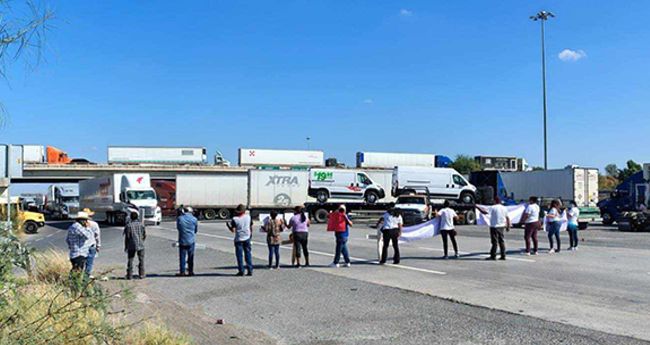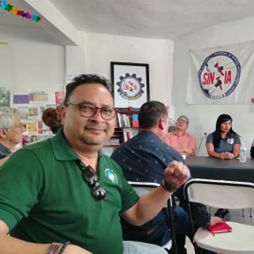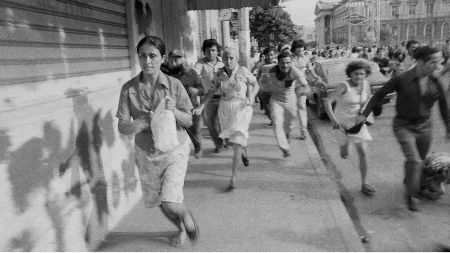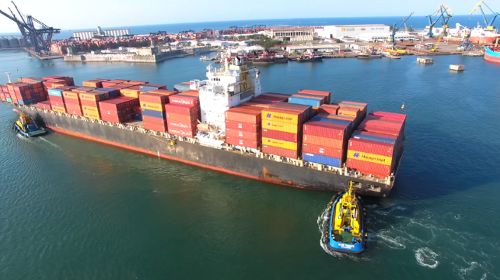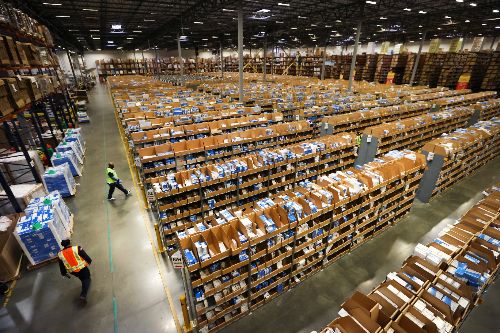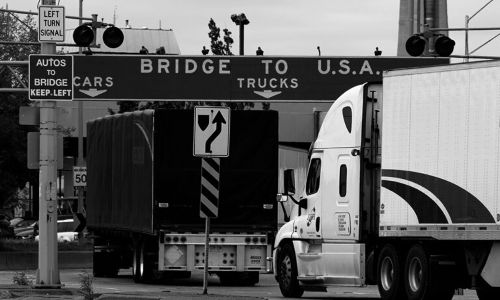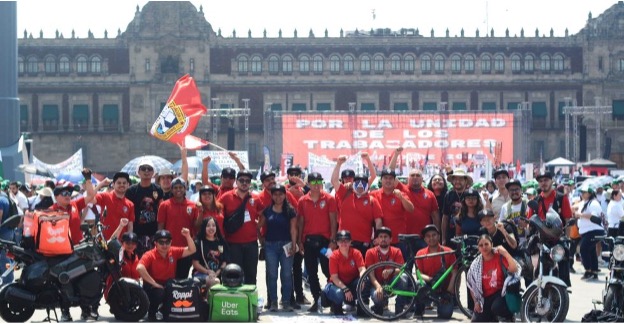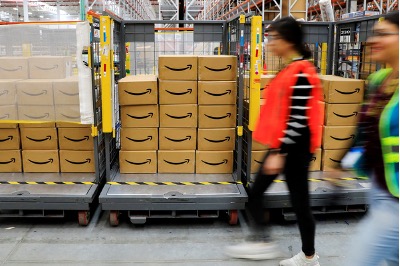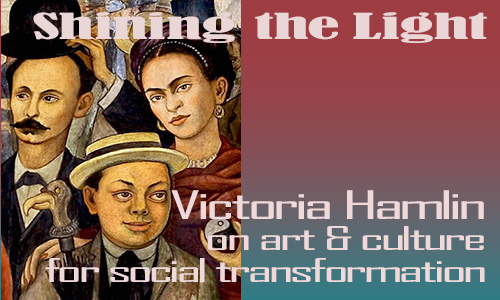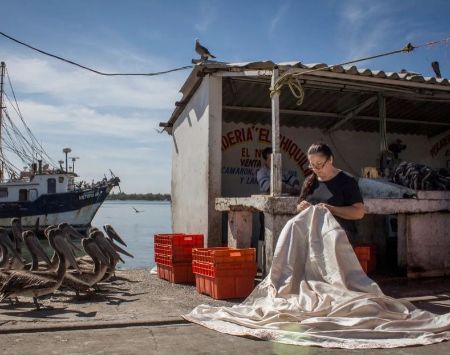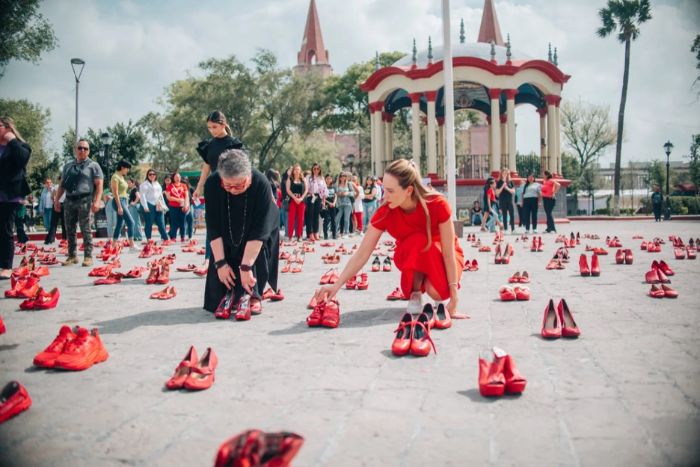|
|
The weekly newsletter of the Mexico Solidarity Project |
|
Every issue archived online at mexicosolidarityproject.org/archives/ |
|
August 20, 2025 |
|
|
|
Delivering the Goods — or Not |
|
Meizhu Lui, for the editorial team |
|
|
|
|
I couldn’t believe my downstairs neighbors. Every day, I’d trip over giant packages from Amazon on our doorstep. After Amazon bought the Whole Foods grocery chain, besides the usual junk we all buy, my neighbors were also ordering their groceries.
I grew up in Ann Arbor, Michigan, where the first Domino’s Pizza opened; it was an event to walk over and stand in line. Now you can get it delivered in Mexico City, Cozumel, Asia and the Middle East! Just click the app, and presto, you’re munching pizza in half an hour, guaranteed.
The goods we buy online are loaded on planes and ships and transported to ports all over the world. They’re then delivered to warehouses. Workers pack them up to fill our orders, and other workers drive them to your city. Pizzas often come by bike.
The race is on to get more and more stuff to you in shorter and shorter amounts of time. The result? The US Bureau of Labor Statistics reported that the fatality rate for "driver/sales workers,” including delivery, was higher in 2022 than for police officers and firefighters.
Dockworkers and truckers have been unionized; warehouse and app workers have not. But with their numbers growing astronomically and their working conditions deplorable, these workers in both Mexico and the US are growing restless! Gilberto Garcia in today’s interview highlights the strategic possibilities of organizing in the distribution sector.
What if dockworkers refused to load ships? What if warehouse workers stopped packing orders? What if no pizza, working mom?! What if workers organized across the entire supply chain?
The world of commerce spins like a wheel of fortune. These workers hold the stick they can poke in the cogs and stop the world from spinning. |
|
|
Workers Who Can Interrupt Global Trade |
|
|
A union stalwart and expert on global supply chains, Gilberto García has organized workers in several countries. Now based in Mexico, as the coordinator for union support activities of the International Transport Workers' Federation, he provides advice and support for various independent union organizing efforts, particularly in the transportation and distribution sector. |
|
How did you become a union organizer and socialist? Which came first?
Both my parents come from families of political and social activists in my native country, El Salvador. In the 1960s, my mother helped found the main teachers' union — from a young age I remember hearing that I was born in a hospital because, during the strike, the teachers won medical services. Because of El Salvador’s political situation, mine is a family of migrants; I have relatives all over the world, and I myself am a migrant, so I understand the movement of peoples. |
|
In high school, as students, we opposed forced recruitment into the army during the 1980s civil war. It was unions that helped us organize. So union organizing and socialism were never separate things for me. |
|
|
Leftist demonstrators flee after Salvadoran National Guard troops fire into a crowd of protesters on the steps of the San Salvador Cathedral in May 1979 Tony Comiti/Sygma via Getty Images |
|
In 2007, after other organizing work, I came to Mexico to support a campaign by the Telefonista union to organize call center workers. |
|
I was the International Union League for Brand Responsibility's staff representative for the Central American and Mexican sector, where I organized garment workers who sew for major brands. That experience has been enriching — I’ve learned about the power of workers acting across borders against large corporations. |
|
|
United Students Against Sweatshops members protest the actions of Russell Athletics in Honduras, where the company closed a factory employing 1,200 people after they unionized. |
|
After 2018, I recognized that Mexico’s new progressive government presented a historic moment of opportunity, and I wanted to be part of its transformation. I’m interested in the movement of goods across the globe, and many multinational companies are here — from the United States, China, Germany, Japan, Korea, Canada... With the 2019 labor reform in a country as influential as Mexico, I believed that the democratic organization of Mexican workers could positively influence the labor movement throughout Latin America.
Trade has always been global. Has the way goods are transported changed and grown in recent decades?
The critical role of global trade flows — supply chains — became clear during the pandemic, when border closures forced many companies to shut down. Since the 1990s and the era of free trade agreements, companies more than ever need smoothly operating supply chains.
While in the past capital accumulation mainly focused on production, today it’s dependent on global distribution. For example, the warehouses of Walmart, Mercado Libre and others are critical to how food gets from the point of production to the consumer. |
|
|
Photo courtesy of Port of Veracruz, 2020 |
|
Similarly, we’ve tracked European auto parts through the port of Veracruz to car factories as far apart as Toluca, Saltillo and Detroit. |
|
Are there specific places in the supply chain where workers could disrupt the entire industry?
The expansion of the distribution sector is also territorial; it has developed strategic zones. In the 1960s, when Ford established its first plant in Cuahutitlán, it led to the industrialization of the entire northern Mexico City area. Ford established plants in various places, with other major automakers following their lead — all automotive production is now centered in the central Bajío region — Guanajuato, San Luis Potosí, and others.
But in terms of distribution, Mexico City’s northern zone has become a major center. Products arrive and depart from the ports of Veracruz and even Lázaro Cárdenas, and by air, from the new Felipe Ángeles International Airport. Products are concentrated in these warehouses, about 45 kilometers north of Mexico City. It’s a very strategic area. |
|
These distribution centers, the next step in the supply chain, now require new kinds of workers — warehouse workers. Think of Walmart — it’s a whale dragging medium and small fish in its wake; behind it are other fish such as Amazon, Mercado Libre and so on. A small city called Teoloyúcan is now called Walmart City — the warehouse is as big as the entire city. The number of these jobs has skyrocketed. |
|
|
Medical Supplies Warehouse: Photo: Brookings Institute, Eleftherios Iakovou and Chelsea C. White, 2020 |
|
Then there are those who do the final deliveries, mostly app workers. In Mexico, the new National Union of App Workers (UNTA) has a great opportunity to grow. A newly won law recognizes app workers not as individual contractors but as employees with labor rights and social security benefits. This counters the growing “uberization” of freight transport. In Mexico, probably about ten large transportation companies carry product components, including auto parts, from warehouses to assembly lines. While they own their own fleet of trucks, some products are seasonal, and for flexibility, they hire individual drivers. |
|
Previously, production workers have almost exclusively held the structural power in organized labor. That’s changed — capital accumulation requires logistics workers to complete its cycle: warehouse workers, truck drivers, delivery drivers. |
|
|
Photo courtesy of Primo Ground Transportation |
|
Factory workers are still critical, of course, but increasingly essential are those who deliver products to an assembly line or to your door in the “last mile." In my opinion, our strategy must be to organize the entire supply chain at the same time; it cannot be store by store or factory by factory.
You coordinate union strengthening activities for the ITF, the International Transport Workers' Federation. Who are your members and what are your objectives?
The ITF was formed in 1898! Its members, particularly dockworkers and maritime workers, used their strategic location in radical ways. For example, in the mid-20th century, the US International Longshoremen's and Warehouse Workers Union, with its history of communist leadership, refused to handle South African goods in solidarity with the anti-apartheid movement.Transport unions, due to their strategic importance, have suffered severe repression. For example, in 2004, Gilberto Soto of the New Jersey Teamsters was assassinated while organizing workers in El Salvador. In 2007, also assassinated was Pedro Zamora, secretary of the Guatemalan port workers' union. |
|
|
UNTA members march to demand recognition of labor relations and rights for platform-based workers in Mexico. Credit: UNTA |
|
Today in Mexico, the ITF has 11 affiliated unions, mainly in aviation and maritime — pilots, air traffic controllers, engineers, ship captains, dockworkers and bus, train and subway driver unions. The newest ones to join are UNTA for app workers and SITRABICS for long-distance cross-border truckers. They are both independent and democratic organizations.
|
|
But something interesting is happening in warehouses: the workforce is mainly composed of women and young workers, who don’t connect with the old style of unionism. I believe they are inclined toward a more activist and democratic style of organization, and I believe that is cause for hope. |
|
|
Amazon warehouse on the outskirts of Mexico City, 2019: Reuters, Carlos Jasso |
|
Though our efforts are still in their infancy and weak, in 2026, the ITF plans to launch a global campaign to organize, strengthen and transform this critical sector, bringing together logistics workers from the food, clothing, automotive and other sectors. These workers possess enormous structural power — they have the potential to paralyze global trade. |
|
|
|
|
Elina Chauvet Mirrors the World |
|
|
Activist Vicky Hamlin, a retired tradeswoman, shop steward, and painter, shines the light — in her art and in this column — on the lives of working people and the world they live in. |
|
|
Elina Chauvet is a true icon; as feminist, artist, speaker of truth to power, she shows us how it is done. Born in Casas Grandes, Chihuahua, Mexico, in 1959, Chauvet is a largely self-taught artist who has been making work about gendered violence for decades. Elina has earned numerous awards, including two at the Biennale Noroeste and a grant from the Culture and Arts Commission of Sinaloa for the 2006-2007 edition of her project, the Reality of Realities. |
|
|
In her performance piece Pietatem, Elina Chauvet appears as an iconic traditional grandmother, dressed in sorrowful black, seated before the Vatican. |
|
|
In Confianza, she sews a white wedding dress; she is seated, with glasses, a ponytail and a black t-shirt. |
|
Different versions of the same woman, who plays roles that mirror herself, us, and our world. These reflections illuminate the worst of the daily horrors and fights of our lives. Because she consistently engages in battles for women — like against domestic violence — Chauvet has been elevated to the status of grande dame in the part of the art world that cares about social justice. |
|
|
Translation: “You look prettier when you’re quiet.“. Hand-embroidered textiles: Heridas Domesticas (Domestic Wounds) (2023–) series. |
|
In her embroidered pieces she mirrors the old-fashioned practice of stitchery with a new message: I have become a strong modern woman. |
|
|
Power, 2020: mixed media |
|
Through her prints, collages and paintings, we travel into the interior workings of her mind. |
|
But the giant mirror of her Red Shoes installation is most telling of the strength of her vision that ties artistic and social justice movements. Only such an icon could pull this off in so many times and places.
In an interview with Latinness, she says:
The project has already been replicated in 27 countries. This year marks 15 years since I started the installation in 2009. My aim is for people to see what I’m seeing occur: that women have taken to the streets to demand and make changes in their lives. Nowadays, I hear young women, and there is no longer submission to abuse. There’s no acceptance, and there’s also a growing awareness among men. They are starting to realize what’s happening, from the subtlest forms of abuse, which become daily occurrences and customs.
With Red Shoes, I want to address all the forms of violence that we endure, and that’s why the artwork exists. |
|
|
Elina Chauvet, Zapatos Rojos (Red Shoes) (2009–) installation in Matamoros, Tamaulipas, 2024: photo Vanessa Olguín |
|
Elina Chauvet’s work forces us to look at hard truths. Her work is not easy. It’s beautiful but not simple, kind of like us. See yourself in there?
I think all human beings deserve dignified lives, right? Without suffering. There are already too many problems in the world, too many things. Let’s get rid of this burden. |
|
|
|
Recent news reports and commentaries, from progressive and mainstream media, |
|
José Luis Granados Ceja, Progressive Leaders Across the Americas Unite Against Growing Global Fascism Truthout. The leaders must now translate positive experiences from the Pan-American Congress into action in their home countries.
Carlos S. Maldonado, Sheinbaum promete la ampliación del Tren Maya a Guatemala y Belice El País.La mandataria se reúne con sus homólogos centroamericanos para discutir temas de cooperación en migración, seguridad, energía limpia y medioambiente.
Mexico leader rebuffs claim that US calls the shots in Mexico China Daily. "President Trump has his way of speaking, but as I said yesterday, the only one who rules in Mexico is the people – plain and simple," Sheinbaum said at her daily press conference. México rechaza despliegue naval de EE.UU. en el Caribe y reivindica autodeterminación de los pueblos Telesur. La presidenta de México, Claudia Sheinbaum, rechazó el intervencionismo, en marco del reciente despliegue naval de Estados Unidos en el Mar Caribe.
Pablo Mariguet, Former Pemex director arrested in the US on corruption charges People’s Dispatch. Mexican authorities allege that Treviño received bribes from the Brazilian company Odebrecht. The arrest and possible extradition come during the Pemex rescue plan announced in August by President Sheinbaum.
Dra. Ana Alicia Solís y Dr. Max Ortega, Octavo consejo nacional extraordinario de Morena Intervención y Coyuntura. El cambio en Morena no es automático: necesita deliberación interna.
Mexico, Guatemala and Belize Launch Trinational Corridor to Protect the Great Maya Forest Telesur English. Mexico, Guatemala and Belize have created the world’s largest biocultural corridor to protect the Great Maya Forest, as environmental groups urge stronger safeguards amid controversy over the Maya Train project.
Jesús García, Primer Centro Libre para Mujeres en Calakmul fortalecerá la autonomía y empoderamiento: Citlalli Hernández Por Esto! El Gobierno Federal inició en Calakmul la creación de una red de Centros Libres para Mujeres, espacios de prevención, orientación y autonomía que buscan extenderse a los más de 2,500 municipios de México.
Talks Continue on Extending Tren Maya Railway Into Belize Love FM. This proposal, discussed with Mexican President Claudia Sheinbaum and her predecessor, Andrés Manuel López Obrador, would connect southern Quintana Roo with Belize and potentially on to Guatemala.
María del Pilar Martínez, CDMX tiene las revisiones contractuales más altas; Frontera Norte sin impacto por aumentos al salario mínimo: Conasami El Economista. 938,866 personas trabajadoras lograron en promedio un incremento salarial nominal de 8.0% y real de 3.9 por ciento. |
|
|
|
|
The Mexico Solidarity Project brings together activists from various socialist and left organizations and individuals committed to worker and global justice. We see the 2018 election of Andrés Manuel López Obrador as president of Mexico as a watershed moment. AMLO and his progressive Morena party aim to end generations of corruption, impoverishment, and subservience to US interests. Our Project supports not just Morena, but all Mexicans struggling for basic rights, and opposes US efforts to undermine organizing and Mexico’s national sovereignty.
Editorial committee: Meizhu Lui, Bruce Hobson, Agatha Hinman, Victoria Hamlin, Courtney Childs, Pedro Gellert. To give feedback or get involved yourself, please email us! |
|
Subscribe! Get the Mexico Solidarity Bulletin in your email box every week. |
|
Web page and application support for the Mexico Solidarity Project from NOVA Web Development, a democratically run, worker-owned and operated cooperative focused on developing free software tools for progressive organizations. |

